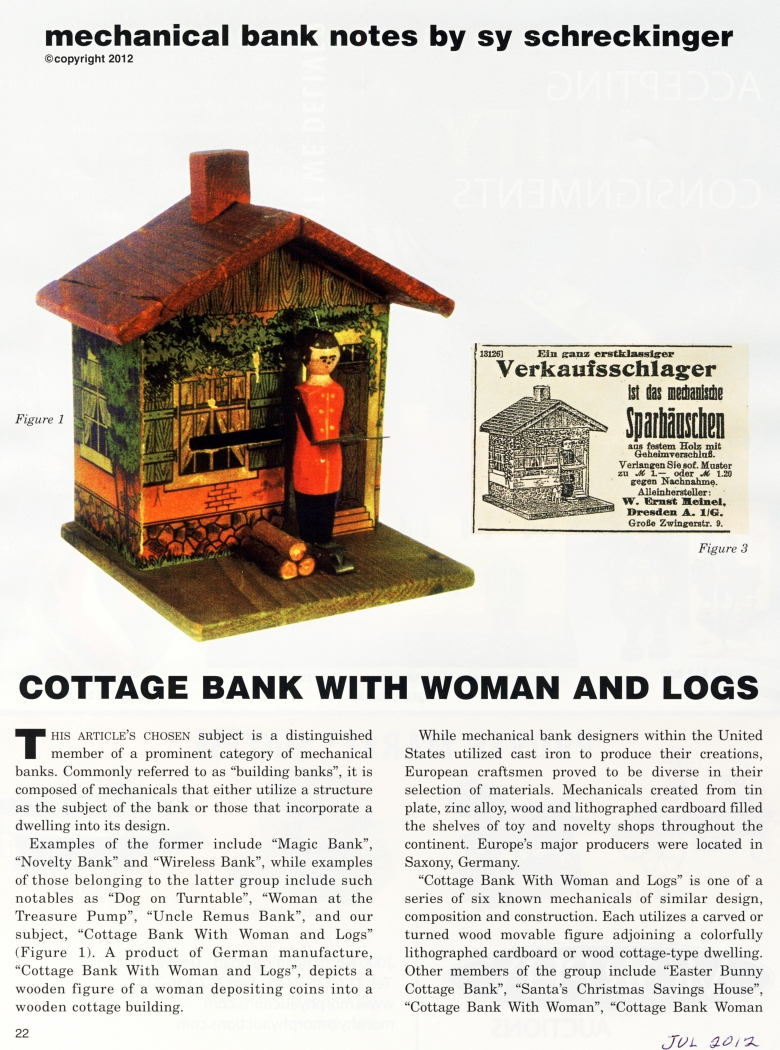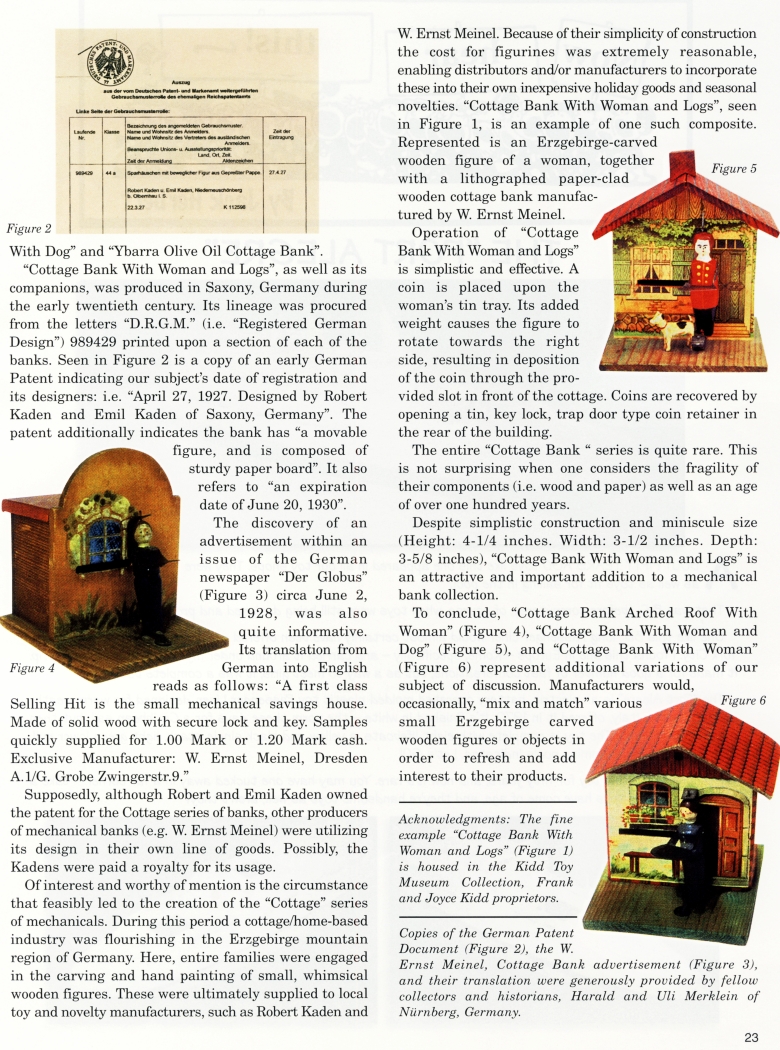|
Cottage Bank with Woman and Logs
by Sy Schreckinger – ANTIQUE TOY WORLD Magazine – July, 2012
THIS ARTICLE'S CHOSEN subject is a distinguished member of a prominent
category of mechanical
banks. Commonly referred to as "building banks", it is composed of
mechanicals that either utilize a structure as the subject of the bank
or those that incorporate a dwelling into its design.
Examples of the former include "Magic Bank", "Novelty Bank" and
"Wireless Bank", while examples of those belonging to the latter group
include such notables as "Dog on Turntable", "Woman at the Treasure
Pump", "Uncle Remus Bank", and our subject, "Cottage Bank With Woman and
Logs" (Figure 1). A product of German manufacture, "Cottage Bank With
Woman and Log?, depicts a wooden figure of a woman depositing coins into
a wooden cottage building.
While mechanical bank designers within the United States utilized cast
iron to produce their creations, European craftsmen proved to be diverse
in their selection of materials. Mechanicals created from tin plate,
zinc alloy, wood and lithographed cardboard filled the shelves of toy
and novelty shops throughout the continent. Europe's major producers
were located in Saxony, Germany.
"Cottage Bank With Woman and Logs" is one of a series of six known
mechanicals of similar design, composition and construction. Each
utilizes a carved or turned wood movable figure adjoining a colorfully
lithographed cardboard or wood cottage-type dwelling. Other members of
the group include "Easter Bunny Cottage Bank", "Santa's Christmas
Savings House", "Cottage Bank With Woman", "Cottage Bank Woman
With Dog" and "Ybarra Olive Oil Cottage Bank".
"Cottage Bank With Woman and Logs", as well as its
companions, was produced in Saxony, Germany during
the early twentieth century. Its lineage was procured
from the letters "D.R.G.M." (i.e. "Registered German
Design") 989429 printed upon a section of each of the
banks. Seen in Figure 2 is a copy of an early German
Patent indicating our subject's date of registration and
its designers: i.e. "April 27, 1927. Designed by Robert
Kaden and Emil Kaden of Saxony, Germany". The
patent additionally indicates the bank has "a movable
figure, and is composed of
sturdy paper board". It also refers to "an expiration date of June 20,
1930".
The discovery of an advertisement within an issue of the German
newspaper "Der Globus" (Figure 3) circa June 2, 1928, was also quite
informative. Its translation from Pigun German into English
reads as follows: "A first class Selling Hit is the small mechanical
savings house. Made of solid wood with secure lock and key. Samples
quickly supplied for 1.00 Mark or 1.20 Mark cash. Exclusive
Manufacturer: W. Ernst Meinel, Dresden A.1/G. Grobe Zwingerstr.9."
Supposedly, although Robert and Emil Kaden owned the patent for the
Cottage series of banks, other producers of mechanical banks (e.g. W.
Ernst Meinel) were utilizing its design in their own line of goods.
Possibly, the Kadens were paid a royalty for its usage.
Of interest and worthy of mention is the circumstance that feasibly led
to the creation of the "Cottage" series of mechanicals. During this
period a cottage/home-based industry was flourishing in the Erzgebirge
mountain region of Germany. Here, entire families were engaged in the
carving and hand painting of small, whimsical wooden figures. These were
ultimately supplied to local toy and novelty manufacturers, such as
Robert Kaden and
W. Ernst Meinel. Because of their simplicity of construction the cost
for figurines was extremely reasonable, enabling distributors and/or
manufacturers to incorporate these into their own inexpensive holiday
goods and seasonal novelties. "Cottage Bank With Woman and Logs", seen
in Figure 1, is an example of one such composite. Represented is an
Erzgebirge-carved wooden figure of a woman, together with a lithographed
paper-clad wooden cottage bank manufactured by W. Ernst Meinel.
Operation of "Cottage Bank With Woman and Logs" is simplistic and
effective. A coin is placed upon the woman's tin tray. Its added weight
causes the figure to rotate towards the right side, resulting in
deposition of the coin through the provided slot in front of the
cottage. Coins are recovered by opening a tin, key lock, trap door type
coin retainer in the rear of the building.
The entire "Cottage Bank " series is quite rare. This is not surprising
when one considers the fragility of their components (i.e. wood and
paper) as well as an age of over one hundred years.
Despite simplistic construction and miniscule size (Height: 4-1/4
inches. Width: 3-1/2 inches. Depth: 3-5/8 inches), "Cottage Bank With
Woman and Logs" is an attractive and important addition to a mechanical
bank collection.
To conclude, "Cottage Bank Arched Roof With Woman" (Figure 4), "Cottage
Bank With Woman and Dog" (Figure 5), and "Cottage Bank With Woman"
(Figure 6) represent additional variations of our subject of discussion.
Manufacturers would,
occasionally, "mix and match" various small Erzgebirge carved wooden
figures or objects in
order to refresh and add interest to their products.
Acknowledgments: The fine example "Cottage Bank With Woman and Logs"
(Figure 1) is housed in the Kidd Toy Museum Collection, Frank and Joyce
Kidd proprietors.
Copies of the German Patent Document (Figure 21. the W. Ernst Meinel.
Cottage Bank
advertisement (Figure Si, and their translation were
generously provided by fellow collectors and historians, Harald and We
Merklein of Niirnberg, Germany. |


